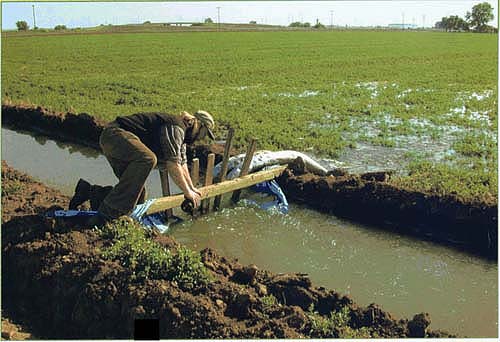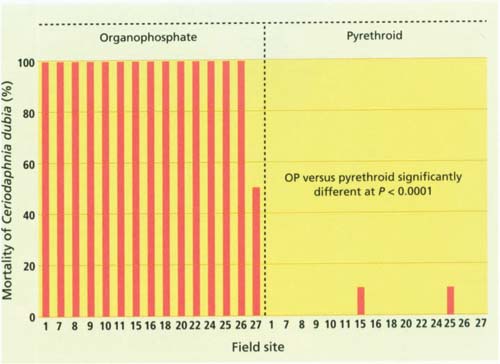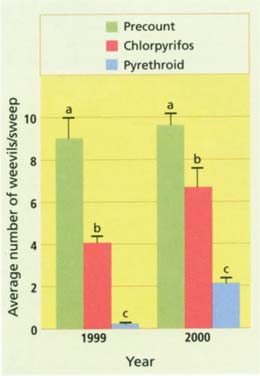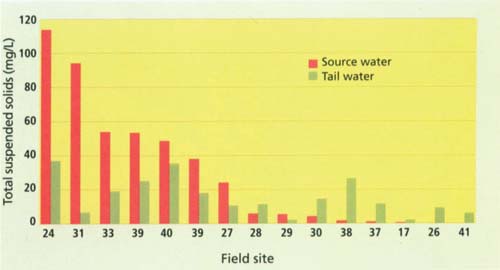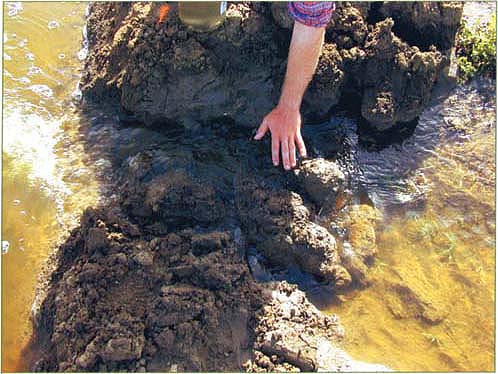All Issues
Insecticide choice for alfalfa may protect water quality
Publication Information
California Agriculture 56(5):163-169. https://doi.org/10.3733/ca.v056n05p163
Published September 01, 2002
PDF | Citation | Permissions
Abstract
Some insecticides used for controlling Egyptian alfalfa weevil have been detected in California's surface waters and are of concern, due to their impact on water quality and toxicity to some aquatic life. To assess the impact of insecticide choice on water quality, we collected tail-water samples from on-farm alfalfa sites in the northern Sacramento Valley over a 3-year period. Samples were collected during irrigation after organophosphate and pyrethroid sprays were applied. We found significant differences between insecticide classes in the mortality of Ceriodaphnia dubia (water flea), a test organism used to detect pesticides in water. Nearly all sites where organophosphate insecticides were used resulted in 100% water flea mortality in a 24-hour test of tail-water samples; pyrethroid-treated sections of the same fields exhibited insignificant flea mortality. The pyrethroids we used provided significantly better control of Egyptian alfalfa weevil than the organophosphates, with no significant differences in beneficial insect counts. Although water runoff does not always occur in alfalfa fields, insecticide choice may be an important tool for protecting water quality. In addition, consideration should be given to the fact that pyrethroids, while they proved advantageous in these experiments, can affect beneficial species and do have high toxicity to fish at extremely low concentrations.
Full text
To investigate the potential movement of organophosphate and pyrethroid insecticides from alfalfa fields, the authors sampled inflows and outflows on alfalfa farms in the northern Sacramento Valley. UC Davis graduate student Corin Pease collects irrigation source water.
Alfalfa is grown on over 1 million acres in California. With an annual value of $873 million in 2001, it ranks as one of the state's top field crops in gross revenue. Alfalfa is primarily used as high-quality feed for dairies, the state's number one agricultural enterprise at about $4.6 billion in 2001. Fields are harvested 6 to 8 times a year in the Central Valley, which produces more than 60% of the state's crop. In this region fields are typically flood irrigated with 4 to 6 inches of water between harvests.
The major insect pest of alfalfa in California is the Egyptian alfalfa weevil (Hypera brunneipennis). The larvae feed on foliage, causing yield and quality losses to the first and sometimes second hay harvests. The most common strategy for Egyptian alfalfa weevil control involves spraying fields once or twice each spring. Insecticides currently used in California for weevil control include the organophosphates (OP) chlorpyrifos (Lorsban and Lock-On), phosmet (Imidan), malathion (Malathion) and dimethoate (Cygon); the pyrethroids permethrin (Ambush), lambda-cyhalothrin (Warrior) and cyfluthrin (Baythroid); and the carbamate carbofuran (Furadan) (Summers and Godfrey 2001). An average of 708,600 pounds of these insecticides was applied to about 1 million acres of California alfalfa annually from 1998 through 2000, with multiple applications on some fields (DPR 2002). The majority of these applications were made for weevil and aphid control in late winter/early spring, with a smaller number of applications to control various worms during the summer. The use of organophosphates predominated; chlorpyrifos, phosmet, malathion and dimethoate accounted for an average of 87% of the mass (weight) of total insecticides applied and 64% of the insecticide applications to alfalfa statewide from 1998 through 2000. Carbofuran accounted for 9% of the mass applied and 9% of the applications, and the pyrethroids permethrin, lambda-cyhalothrin and cyfluthrin accounted for 4% of the mass applied and 27% of the applications in the same period (DPR 2002).
Water quality concerns
Irrigation and storm-water runoff from agriculture, including alfalfa, have been implicated as contributing to the presence of chlorpyrifos, malathion and carbofuran in California surface waters at levels that cause mortality to the water flea Ceriodaphnia dubia (SWRCB 2002; deVlaming et al. 2000; Foe and Sheipline 1993). The detection of these insecticides has caused several waterways to be classified as failing to meet water quality standards, as defined by the U.S. Environmental Protection Agency and the State Water Resources Control Board (SWRCB). Section 303(d) of the federal Clean Water Act mandates that total maximum daily load (TMDL) restrictions be developed to improve water quality in affected waterways. A TMDL is the maximum quantity of a pollutant that can enter a water body without adversely affecting beneficial uses. The TMDLs for chlorpyrifos, malathion and carbofuran must be established between 2005 and 2011 for the Central Valley (Region 5), depending on the waterway.
Alfalfa, one of California's top field crops, is used primarily as feed for the state's dairy industry. The federal Clean Water Act will require Central Valley growers, including alfalfa farmers, to limit insecticide pollution in waterways in coming years.
Regulatory implications
An agreement between the California Department of Pesticide Regulation (DPR) and the SWRCB outlines a four-stage process for protecting water quality ( see page 148 ). The first step involves voluntary grower efforts to reduce offsite movement of an insecticide, while later steps require further restrictions or regulation by DPR or the regional water quality boards. At this writing, regulators were encouraging voluntary steps to reduce the presence of these compounds in natural waterways. However, further restrictions and regulations may be forthcoming for some insecticides such as chlorpyrifos.
Alfalfa management limitations
There are few nonchemical management practices available to control Egyptian alfalfa weevil. While early harvest can reduce feeding damage, this option is often not economically viable or is restricted by spring rains. Beneficial insects such as parasitic wasps are natural weevil enemies but generally do not provide sufficient control. Although modern alfalfa varieties are resistant to many pests, a cultivar has yet to be developed that is resistant to the Egyptian alfalfa weevil (Summers 1998). Planting other forages such as berseem clover or oats into established alfalfa mitigates weevil damage, but is limited by market acceptance and management constraints.
Most growers continue to use insecticides for compelling economic reasons. However, all insecticides do not present the same risks to the environment, nor do all insecticide-treated fields affect natural waterways. Insecticides differ in properties such as solubility, adherence to soil particles and toxicity to aquatic invertebrates (table 1). Therefore, certain classes of insecticides may be better suited to prevent off-site pesticide movement from farms where irrigation water drains into natural waterways.
Measuring water quality
Aquatic biologists commonly use C. dubia as a test organism to help characterize the risk of toxins to aquatic invertebrates (deVlaming and Norberg-King 1999). Although the use of this invertebrate as the key predictor of the environmental impact of pesticides has been the subject of debate, it continues to be used to detect pesticides in water due to its extreme sensitivity to toxins present at very low (parts per billion [ppb]) concentrations (table 1).
The objective of this study was to evaluate the insect control efficacy of organophosphates and pyrethroids, as well as their effect on the mortality of C. dubia in tail-water samples obtained from alfalfa production fields.
Field studies
Commercial alfalfa fields (22 in 1999, 9 in 2000 and 10 in 2001) were selected as study sites in the northern Sacramento Valley (table 2). In 1999 and 2000, nearly all fields were divided into two distinct test areas: one received an organophosphate insecticide for weevil control and the other received a pyrethroid treatment. Each test area was a 20- to 60-acre block and each farm was considered a replication. In 2001, monitoring was restricted to seven alfalfa fields treated with lambda-cyhalothrin (a pyrethroid) at labeled rates.
Each year, all fields were treated with insecticides once in the late winter/early spring when weevils reached economic threshold levels of 15 to 20 larvae per sweep, or when significant damage to the alfalfa was observed (Summers and Godfrey 2001). Application dates ranged from March 10 to April 9 in all 3 years. Insecticides were applied by air or ground at 10 to 15 gallons per acre within each field. There was a range of days between application and water runoff sampling, due to irrigation differences.
Toxicity testing
Water samples were collected from each test area using standard methods employed by the UC Davis Aquatic Toxicology Laboratory (Emanuel and Cabugao 2000). We collected 2 gallons of unfiltered water from the head irrigation ditch as water entered the alfalfa fields (source water) and 2 gallons from the end of the field as the water flowed off (tail water). All sites had one to several locations where water exited the fields. Toxicity testing occurred within 48 hours of collection. In 1999 and 2000, all water samples were collected from the first irrigation of the year, which occurred 22 to 62 days after the fields were sprayed. During our study, in 1999 there were 10 rainfall events with a total of 2.7 inches; in 2000, 8 events with 2.8 inches; and in 2001, 7 events with 1.5 inches. Rainfall was not sufficient to cause runoff from the treatment fields. Tests for mortality of C. dubia were done according to standardized 24-hour and 96-hour toxicity testing procedures.
TABLE 2. Alfalfa insecticide treatment comparisons for field studies conducted in the northern Sacramento Valley, 1999-2001
Dilution tests
During both 1999 and 2000, all field samples that resulted in 100% mortality within 24 hours were resampled and diluted with varying amounts of control water. A dilution series was created with concentrations of 50%, 25%, 12.5%, 6.25%, 3.12%, 1.56% and 0.78% by volume of the original tail-water sample. These dilutions were then subdivided to create two sample sets, in addition to laboratory water as a control. In one set, we added piperonyl butoxide (PBO) at 100 ppb (μg/L), which inhibits the toxicity of metabolically activated organophosphate insecticides such as chorpyrifos (Bailey et al. 1996). If the addition of PBO renders a toxic sample nontoxic, crganophosphate insecticides are indicated as a likely source of C. dubia mortality. The other set of serial dilutions was used to determine the dilution necessary to render the original field sample nontoxic.
Chemical analyses of pyrethroids
In 2001, chemical analyses were performed on tailwater samples from the alfalfa study fields treated with lambcla-cyhalothrin to confirm the apparently negligible transport of the insecticide in irrigation runoff indicated by our mortality tests. One-liter samples were collected from the source water, and replicate 0.5-liter samples were collected from the tail water. Five sites were sampled during the first irrigation, 41 to 53 days after the alfalfa fields were sprayed for weevil control, and one site was sampled during the second irrigation 62 days after treatment. All water samples were extracted into hexane within 24 hours after collection and stored at -4°F). All samples were analyzed using a gas chromatograph/mass spectrophotometer, to a detection limit of 50 ppt (parts per trillion [ppt]) for lambda-cyhalothrin.
Fig. 1. Effect of insecticide choice on mortality of C. dubia (water flea) in a 24-hour test from 15 paired field comparisons, Sacramento Valley. Samples were taken from alfalfa tail water flowing from fields due to irrigation events after insecticide application. In all organophosphate tail-water samples, when piperonyl butoxide (PBO) was added mortality was zero; prevention of mortality with PBO is an indication of organophosphate toxicity. All organophosphate insecticide tail-water samples were diluted more than 85% before mortality of C. dubia was reduced to zero.
Fig. 2. Average number of weevils per sweep (± SE) in 1999 and 2000 for precounts (prior to treating fields) and for chlorpyrifos- and pyrethroid-treated fields (mean of 10 paired sites in 1999 and 8 paired sites in 2000). Different letters refer to significant differences between treatments at P ≤ 0.05.
Suspended solids
During each study year, we also collected total suspended solid (TSS) samples from irrigation source water and tail water from 15 of the study field sites to determine the quantity of soil particulate matter moving off alfalfa fields.
Insect counts
Insect populations were quantified in 1999 and 2000 in plots that were treated with chlorpyritos or pyrethroids, by taking 10 sweeps with a standardized sweep net per treatment in four areas of the field. Average counts of beneficial insects and pests were recorded before and after fields were sprayed in March, and also just prior to the second, third and fifth harvests. Beneficial insects monitored included lady beetles (Hippodamia spp.), lacewings (Chrysoperla spp.), minute pirate bugs (Orius spp.), big-eyed bugs (Geocoris spp.), damsel bugs (Nabis spp.), aphidiid wasps and Collops beetles. Pests included Egyptian alfalfa weevil, pea and blue alfalfa aphid (Acyrthosiphon spp.) and spotted alfalfa aphid (Therioaphis sp). In 2000, aphids were sampled by taking 10 stem samples per plot in four areas of the field and recording averages per stem per treatment. Insect counts were pooled for the pyrethroid (lambdacyhalothrin and cyfluthrin) treatments because there were no significant differences in insect counts between these treatments (P > 0.05). Data were analyzed using a one-way ANOVA with Tukey-Kramer HSD for means separation.
Water sampling for insecticides
We made direct comparisons between organophosphate- and pyrethroid-treated areas in 16 fields. Several other experimental sites were eliminated due to contamination of the pyrethroid treatment with an organophosphate insecticide, no water runoff, source-water contamination, no paired treatments, application change, no weevil treatment, no pyrethroid sample or no confirmation of organophosphate mortality (table 2).
Organophosphates
In 1999 and 2000, 14 of 16 tail-water samples collected from organophosphate-treated alfalfa plots caused 100% mortality to C. dubia within 24 hours (fig. 1). One chlorpyrifos-treated tail-water sample caused 100% mortality in 3 days (site 3), and one phosmet tail-water sample caused 50% mortality within 1 day (site 27). The source-water samples from these same fields had nearly zero mortality, except three sites (16, 25, 27) that had between 10% and 20% mortality.
This low level of C. dubia mortality in the source samples could have been due to the presence of toxins in the source water, or natural variation in the response of the organism in laboratory tests. Mortality in laboratory control water was zero in all but one of the sites in a 24-hour test.
Dilution tests
In a 96-hour dilution test, organophosphate tail-water samples collected from 18 sites were diluted to less than 15% of the initial concentration before mortality of C. dubia was reduced to zero. In most samples, it was necessary to dilute the samples to less than 6% of the initial concentration before mortality was zero. When PBO was added, the test organism survived in all these organophosphate-treated tail-water samples. After 96 hours, mortality in the laboratory control samples was between 10% and 20% at three sites (11, 18, 25). With PBO, mortality in the laboratory control samples was between 5% and 20% at six sites (9, 10, 12, 20, 22, 24). Mortality for these control samples was likely within the range of normal experimental variation. Dilution tests were not done for sites with less than 100% mortality after 24 hours (sites 3 and 27).
Pyrethroids
There was near zero mortality of the C. dubia in a 24-hour test in the samples collected from pyrethroid-treated alfalfa fields (fig. 1). Although slight mortality was observed in these treatments, these results are likely well within those that could be expected from natural variation in the control-water samples.
Fig. 3. Total suspended solids (TSS, mg/L) for source- versus tail-water samples, 1999-2001. Average TSS for source water was 30.1 mg/L versus 16.2 mg/L for tail water, with no significant difference at P > 0.17.
Pyrethroid analyses
Samples were taken in 2001 from six pyrethroid-treated fields, to analytically evaluate the presence of pyrethroids in tail-water samples. Lambda-cyhalothrin was not detected by gas chromatograph/mass spectrophotometer analysis in any of the source-or tail-water samples to a detection limit of 50 ppt (ng/L). Lambda-cyhalothrin added to source water (spiked) at 0.1 to 10 ppb resulted in recoveries ranging from 53% to 74%, substantiating that sampling methods did not interfere with detection (table 3).
TABLE 3. Detection of lambda-cyhalothrin insecticide by gas chromatograph/mass spectrophotometry (GC/MS) in source- and tail-water samples from six fields where this insecticide was applied, 2001
Weevil control
In 1999 and 2000 the pyrethroid insecticides lambda-cyhalothrin and cyfluthrin controlled the Egyptian alfalfa weevil significantly better than the organophosphate chlorpyrifos, but both treatments kept the weevils below the threshold level of 15 to 20 larvae per sweep (fig. 2). In 1999 and 2000, there were no significant differences in beneficial insect counts between the chlorpyrifos or pyrethroid treatments (data not shown). There were no significant differences in aphid counts during harvests 1, 3 and 5 in the chlorpyrifos versus pyrethroid treatments. In the second harvest in 1999, there were significantly more aphids in the pyrethroid treatments compared with chlorpyrifos-treated fields, and similar trends (but lack of significance) in 2000.
Properties of insecticides
Regardless of the application rate or specific organophosphate insecticide applied for Egyptian alfalfa weevil control, exposure to irrigation tail water from all organophosphate-treated field sites caused mortality to C. dubia. In contrast, we did not observe significant C. dubia mortality in irrigation tail water collected from pyrethroid-treated alfalfa fields, nor did we find pyrethroid residues in tail-water samples to a detection limit of 50 ppt (ng/L).
Pollution from sediment in runoff, above, was not found to be a significant problem on the alfalfa farms tested.
Differences in solubility, binding coefficients and toxicity (table 1) may account for the differences we found between classes of compounds. Pyrethroids are hydrophobic with very low water solubility. They are rapidly adsorbed to leaf surfaces and soil organic matter and apparently are not readily transported in runoff in the aqueous phase (table 1). Pyrethroids can move off-site attached to soil particles, where they may accumulate in silt deposits and potentially provide a source of exposure to aquatic life.
For alfalfa, this does not appear to be a severe problem because its deep roots and vigorous canopy help protect the soil from being transported during irrigation or due to wind erosion. The total suspended solids (TSS) data collected during our study showed that very little soil or sediment moved off-site in irrigation tail water (fig. 3). The concentration of TSS in irrigation source-water samples averaged 30.1 ± 9.5 mg/L compared with 16.2 ± 2.9 mg/L for tail water, a difference that was not statistically significant (P > 0.17). However, where source water was high in TSS, there was a tendency for a reduction in TSS in the tail water (fig. 3), indicating that the alfalfa crop may trap sediments. Particulate matter moving from agricultural fields may be subject to TMDLs in the future. The National Academy of Sciences considers 25 mg/L a very high level of protection for aquatic life, which in most cases was met in our tail-water samples.
In contrast to pyrethroids, organo-phosphate insecticides are moderately water-soluble, have lower binding coefficients than the pyrethroids, and may move in solution with irrigation or rainwater (table 1). Exposure to tail-water samples, 22 to 62 days after organophosphate field application and diluted to 15% to 1.6% of the initial concentration, still resulted in C. dubia mortality in a standard 96-hour toxicity test. Similarly, in a previous study researchers showed C. dubia mortality in irrigation tail water collected from chlorpyrifos-treated alfalfa fields up to seven irrigations after application (deVlaming, unpublished data).
Tradeoffs: efficacy, pest control
The efficacy of weevil control in pyrethroid-treated fields was significantly better than in the organophosphate-treated fields in our studies (fig. 2).
However, weevil levels were below economic thresholds in most cases. Entomologists have been cautious about the use of pyrethroids in alfalfa due to potential impacts upon beneficial insects and insect interactions, possibly causing outbreaks of other pests that could require additional insecticide treatments (L. Godfrey, C. Summers, personal communication). Alfalfa is also considered a year-round reservoir for beneficial insects that may help control pests in other crops (such as cotton) and excessive pyrethroid use may disrupt this important function.
In our study we did not observe any adverse effects of pyrethroid use in alfalfa on beneficial insect populations, as compared with chlorpyrifos treatments. This could have been due, at least in part, to timing. Entomol-ogists have known that proper timing of insecticide applications may produce a selective action on the pest and natural enemy complex. The alfalfa fields in our study were treated in late winter/early spring when aphid and beneficial insect popu-lations were extremely low. Other studies have shown similar results in alfalfa, where early-season treatment for Egyptian alfalfa weevil had minimal effects on beneficial insects.
We did observe an effect on aphid populations during the second harvest period. In 1999 there were significantly more aphids in the pyrethroidtreated plots during the second harvest, and the same trend was observed during 2000. However, these aphid counts declined significantly by the third cutting and never required insecticide treatments.
There are often limitations and tradeoffs with regard to pesticide choice in terms of efficacy, effect on nontarget organisms, economics, and risks to the environment. The use of pyrethroids and their potential impact upon beneficial insects must be weighed against the propensity of organophosphate insecticides to move off-site in tail water.
Insecticide choice, water quality
This study demonstrated that alfalfa fields sprayed with organophosphate insecticides have the potential to contribute concentrations of organo-phosphates in tail water sufficient to cause mortality in the test organism C. dubia. Mortality occurred in all the observed field sites 22 to 62 days after application under a range of application rates and field conditions. Samples required considerable dilution before mortality was eliminated, suggesting that prevention of organophosphate runoff by growers may be difficult without changes in pest control techniques or irrigation practices. The group of pyrethroid insecticides we examined was not detected in tail water. They were effective at controlling the targeted Egyptian alfalfa weevil in our study and had no effects on beneficial insects.
However, the potential of pyrethroids to affect beneficial insects, and their high toxicity to fish (especially from application drift onto waterways), should be carefully considered when choosing insecticides. Many factors may influence the movement of insecticides, such as agronomic practices in different crops, soil type and pesticide properties including water solubility (Werner et al. 2002). While the full biological significance of C. dubia mortality caused by organophosphate insecticides is not known, choice of insecticide may be important to prevent contamination in areas where surface water runoff from alfalfa fields directly impacts natural waterways.
Clean water laws are targeted to protect beneficial water uses such as habitat for wildlife and aquatic organisms. Insecticide choice may be an important factor to consider in areas where alfalfa runoff affects waterways. Above, birds feed on insects and rodents in fields near an irrigation water source.



